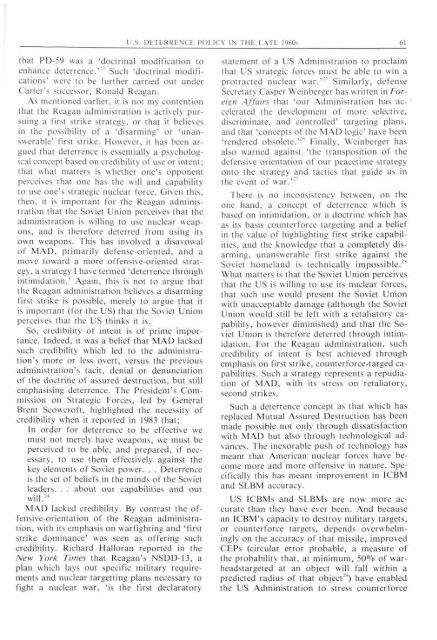ISSUE 76 : May/Jun - 1989 - Australian Defence Force Journal
ISSUE 76 : May/Jun - 1989 - Australian Defence Force Journal
ISSUE 76 : May/Jun - 1989 - Australian Defence Force Journal
- No tags were found...
You also want an ePaper? Increase the reach of your titles
YUMPU automatically turns print PDFs into web optimized ePapers that Google loves.
U.S. DETERRENCE POLICY IN THE LATE 1980s 61that PD-59 was a 'doctrinal modification toenhance deterrence.' 2 ' Such 'doctrinal modifications'were to be further carried out underCarter's successor, Ronald Reagan.As mentioned earlier, it is not my contentionthat the Reagan administration is actively pursuinga first strike strategy, or that it believesin the possibility of a 'disarming' or 'unanswerable'first strike. However, it has been arguedthat deterrence is essentially a psychologicalconcept based on credibility of use or intent;that what matters is whether one's opponentperceives that one has the will and capabilityto use one's strategic nuclear force. Given this,then, it is important for the Reagan administrationthat the Soviet Union perceives that theadministration is willing to use nuclear weapons,and is therefore deterred from using itsown weapons. This has involved a disavowalof MAD, primarily defense-oriented, and amove toward a more offensive-oriented strategy,a strategy I have termed 'deterrence throughintimidation.' Again, this is not to argue thatthe Reagan administration believes a disarmingfirst strike is possible, merely to argue that itis important (for the US) that the Soviet Unionperceives that the US thinks it is.So, credibility of intent is of prime importance.Indeed, it was a belief that MAD lackedsuch credibility which led to the administration'smore or less overt, versus the previousadministration's tacit, denial or denunciationof the doctrine of assured destruction, but stillemphasising deterrence. The President's Commissionon Strategic <strong>Force</strong>s, led by GeneralBrent Scowcroft, highlighted the necessity ofcredibility when it reported in 1983 that;In order for deterrence to be effective wemust not merely have weapons, we must beperceived to be able, and prepared, if necessary,to use them effectively against thekey elements of Soviet power. . . Deterrenceis the set of beliefs in the minds of the Sovietleaders. . . about our capabilities and ourwill. 24MAD lacked credibility. By contrast the offensive-orientationof the Reagan administration,with its emphasis on warfighting and 'firststrike dominance' was seen as offering suchcredibility. Richard Halloran reported in theNew York Times that Reagan's NSDD-13, aplan which lays out specific military requirementsand nuclear targetting plans necessary tofight a nuclear war, 'is the first declaratorystatement of a US Administration to proclaimthat US strategic forces must be able to win aprotracted nuclear war.' 2 ' Similarly, defenseSecretary Casper Weinberger has written in ForeignAffairs that 'our Administration has acceleratedthe development of more selective,discriminate, and controlled' targeting plans,and that 'concepts of the MAD logic' have been'rendered obsolete.' 26 Finally, Weinberger hasalso warned against 'the transposition of thedefensive orientation of our peacetime strategyonto the strategy and tactics that guide us inthe event of war.' 2There is no inconsistency between, on theone hand, a concept of deterrence which isbased on intimidation, or a doctrine which hasas its basis counterforce targeting and a beliefin the value of highlighting first strike capabilities,and the knowledge that a completely disarming,unanswerable first strike against theSoviet homeland is technically impossible. 2hWhat matters is that the Soviet Union perceivesthat the US is willing to use its nuclear forces,that such use would present the Soviet Unionwith unacceptable damage (although the SovietUnion would still be left with a retaliatory capability,however diminished) and that the SovietUnion is therefore deterred through intimidation.For the Reagan administration, suchcredibility of intent is best achieved throughemphasis on first strike, counterforce-targed capabilities.Such a strategy represents a repudiationof MAD, with its stress on retaliatory,second strikes.Such a deterrence concept as that which hasreplaced Mutual Assured Destruction has beenmade possible not only through dissatisfactionwith MAD but also through technological advances.The inexorable push of technology hasmeant that American nuclear forces have becomemore and more offensive in nature. Specificallythis has meant improvement in ICBMand SLBM accuracy.US ICBMs and SLBMs are now more accuratethan they have ever been. And becausean ICBM's capacity to destroy military targets,or counterforce targets, depends overwhelminglyon the accuracy of that missile, improvedCEPs (circular error probable, a measure ofthe probability that, at minimum, 50% of warheadstargetedat an object will fall within apredicted radius of that object 29 ) have enabledthe US Administration to stress counterforce
















